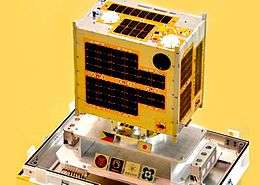Philippine Earth Data Resources Observation Center
The Philippine Earth Data Resource and Observation Center, also known as the PEDRO Center is an organization tasked in operating satellite ground stations.
 | |
 | |
| Established | 2016 |
|---|---|
| Research type | Satellite ground station network |
| Location | Quezon City and Davao City, Philippines |
| Affiliations | Department of Science and Technology |
Operating agency | Advanced Science and Technology Institute |
| Website | asti |
It is part of the Philippine Scientific Earth Observation Micro-satellite (Phil-Microsat) program by the Department of Science and Technology, which includes the deployment of the Diwata-1 and Diwata-2 microsatellites.[1] It also receives information from commercial satellites.[2]
History
The Philippine Earth Data Resource and Observation (PEDRO) Center project was implemented by the Advanced Science and Technology Institute of the Department of Science and Technology in December 2016 following the launch of the Philippines' first microsatellite, Diwata-1 on April 26, 2016. The project was implemented to be able to establish a ground receiving station that would gather data from satellites. [3]
Satellite ground stations
PEDRO's first satellite ground station is situated at the Department of Science and Technology–Advanced Science and Technology Institute (DOST–ASTI) facility at the University of Philippines Diliman in Quezon City, Philippines.[4] The facility has a 3.7 meters (12 ft) satellite tracking antenna.[5]
The ground station was initially planned to be located inside the Subic Bay Freeport Zone in Subic, Zambales.[6] This plan was reportedly changed in March 2016, with the ground station to be built in Diliman, Quezon City instead. Construction began in 2016[7] and PEDRO became operational by June 2017.[4]
The second satellite ground station was launched on June 30, 2019[8] and is located at the Civil Aviation Authority of the Philippines (CAAP) Transmitter Facility in Davao City's Francisco Bangoy International Airport.[5] The Davao facility has a 7.3 meters (24 ft) satellite tracking antenna and a 12.19 meters (40.0 ft) container van which serves as a control room.[9]
A third ground station is being set up in Dumangas, Iloilo and is planned to be operational by July 2020. The Iloilo station will be financed by the Japan International Cooperation Agency. the first two stations was funded by the DOST.[10]
| Ground station | Location | Coordinates |
|---|---|---|
| ASTI Ground Receiving Station | University of the Philippines Diliman, Quezon City | 14.647219°N 121.0719533°E |
| Davao Ground Receiving Station | Francisco Bangoy International Airport, Davao City | |
Linked satellites
Aside from the PHL-Microsat satellites the Pedro Center has access to data of other third-party satellites.[3]
- Multispectral satellites
- Diwata-1
- Diwata-2
- Maya-1
- KompSat-3
- PlanetScope (Constellation of 100+ nanosatellites)
- RapidEye
- GeoEye-1
- WorldView-1
- WorldView-2
- WorldView-3
- Sentinel-2A
- Sentinel-2B
- SAR satellites
- KompSat-5
- Cosmo-Skymed
References
- Yee, Jovic (12 January 2015). "1st PH-made satellite set to go into space". Philippine Daily Inquirer. Retrieved 13 January 2016.
- Icamina, Paul (28 March 2016). "'Diwata' a step closer to orbit". Malaya. Retrieved 28 March 2016.
- "PEDRO Center - History". Advanced Science and Technology Institute. Retrieved 1 July 2019.
- Usman, Edd (5 June 2017). "How Diwata-2 is better than PH's first satellite, Diwata-1". Rappler. Retrieved 6 June 2017.
- Nazario, Dhel (30 June 2019). "Davao ground receiving station launched soon". Manila Bulletin. Retrieved 1 July 2019.
- Ranada, Pia (10 March 2015). "Introducing Diwata, the first Philippine-made satellite". Rappler. Retrieved 12 March 2015.
- Ronda, Rainier Allan (24 March 2016). "US aircraft with Philippines's first microsatellite launched into space". The Philippine Star. Retrieved 28 March 2016.
- Palicte, Che (2 July 2019). "PH's largest satellite-tracking antenna launched in Davao". Philippine News Agency. Retrieved 4 July 2019.
- "Largest Ground Receiving Station in PH operates this 2019". Edge Davao. Retrieved 1 July 2019.
- Arayata, Maria Cristina (29 January 2020). "More PH-Japan S&T collaboration underway". Philippine News Agency. Retrieved 31 January 2020.
.jpg)
